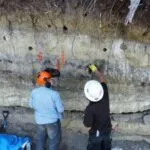Last year, researchers made a groundbreaking discovery in the Lost World Italian Alps: stunningly preserved fossils of reptilian footprints and underbellies. These remarkable finds have provided a window into a prehistoric tropical lakeside ecosystem that existed long before the age of dinosaurs
Headlines
Hiker Discovers 280-Million-Year-Old Fossilized ‘Lost World’ in the Italian Alps

While hiking in the Italian Alps, Claudia Steffensen stumbled upon an extraordinary piece of history—a fragment of a 280-million-year-old ecosystem complete with prehistoric footprints, plant fossils, and even imprints of ancient raindrops, researchers have confirmed.
The discovery occurred in Valtellina Orobie Mountains Park in Lombardy in 2023. As Steffensen walked behind her husband, she noticed an unusual rock resembling a slab of cement. “I then noticed these strange circular designs with wavy lines,” she told The Guardian. “I took a closer look and realized they were footprints.”
Scientists analyzed the rock and identified the footprints as belonging to a prehistoric reptile. This incredible find not only provides insights into life during the Permian period but also raises intriguing questions about what other secrets might be concealed within the Alpine terrain. Steffensen’s “rock zero” serves as a starting point for uncovering lost world more about this ancient tropical ecosystem.
Experts have conducted several expeditions to the discovery site and unveiled evidence of a well-preserved ecosystem dating back to the Permian period (299–252 million years ago). This era, marked by a rapidly warming climate, ended in the catastrophic “Great Dying,” an extinction event that eradicated 90% of Earth’s species.
The site contains fossilized footprints from a diverse array of ancient creatures, including reptiles, amphibians, insects, and arthropods, which often align to form discernible “tracks.” Accompanying these tracks, researchers identified fossilized seeds, leaves, and stems, along with fascinating imprints of raindrops and wave patterns from a prehistoric lake. These remnants of life have been discovered across a range of elevations—from 9,850 feet (3,000 meters) in the mountains to the valley floors, where landslides over millions of years deposited fossil-rich rocks.
The incredible preservation of this ecosystem is attributed to its close relationship with water. The fossils are captured in fine-grained sandstone, which formed on the muddy shores of ancient rivers and lakes. According to Ausonio Ronchi, a paleontologist at the University of Pavia in Italy, the footprints were made when these surfaces were water-soaked sand and mud. Seasonal drying under the summer sun hardened the ground, preventing the return of water from erasing the impressions. Instead, the subsequent layers of clay and sediment sealed the footprints, preserving them for millions of years.
This discovery not only offers a rare glimpse into a long-lost world but also provides key insights into how ecosystems responded to the extreme environmental changes of the Permian period.

A large boulder with fossilized footprints of amphibians and reptiles aligned to form tracks. (Image credit: Photo by Elio Della Ferrera, © Superintendency of Archaeology, Fine Arts and Landscape provinces of Como, Lecco, Monza-Brianza, Pavia, Sondrio and Varese.)
The fine grain of the sand and mud at the site has preserved even the most intricate details of ancient life, including claw marks and patterns from the underbellies of animals. According to the researchers, these imprints represent at least five different animal species, some of which could have grown as large as modern-day Komodo dragons (Varanus komodoensis), reaching lengths of 6.5 to 10 feet (2 to 3 meters). This remarkable level of preservation provides an extraordinary look into the behavior and physical characteristics of creatures that roamed the Earth lost world over 280 million years ago.

Researchers move fossils onto spongy white material for transportation on Oct. 21, 2024. (Image credit: Photo by Elio Della Ferrera, © Superintendency of Archaeology, Fine Arts and Landscape of the provinces of Como, Lecco, Monza-Brianza, Pavia, Sondrio and Varese.)
“At that time, dinosaurs did not yet exist, but the animals responsible for the largest footprints found here must still have been of a considerable size,” said Cristiano Dal Sasso, a vertebrate paleontologist at the Natural History Museum of Milan, who was the first expert contacted about the discovery.
The fossils provide a rare glimpse into a fascinating, long-gone world, inhabited by creatures that went extinct at the end of the Permian period. However, the researchers also emphasized the importance of these findings in understanding our current environmental challenges.
Many of the prehistoric imprints would have remained hidden if not for climate change, which is rapidly reducing the ice and snow cover in the Alps. “These fossils … testify to a distant geological period, but with a global warming trend completely similar to that of today,” the researchers noted. “The past has a lot to teach us about what we risk getting the world into now.”
This discovery lost world highlights not only the incredible preservation of ancient life but also serves as a powerful reminder of the potential consequences of current climate trends, offering valuable lessons for the future.






